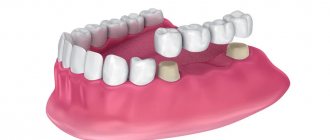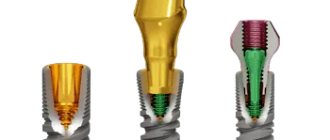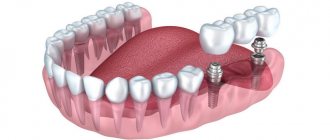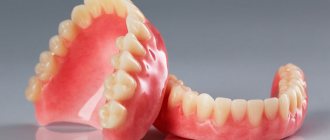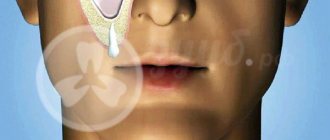For many people, losing multiple teeth seriously impacts their quality of life. At the same time, the patient is often at a loss before choosing which type of prosthetics he prefers and what is better for him: a bridge or an implant? We propose to weigh all the possible “pros” and “cons” of both methods of prosthetics, answering all possible important questions.
A little about bridges
Popularly, bridges are called the short word “bridge”. They received this name in dentistry due to the peculiarities of fixation. This type of dentures is represented by crowns, which are held on adjacent “supporting” teeth and replace the functions of their missing “brothers”. Thanks to the paired supporting fastening system, such a prosthesis is called a bridge.
A bridge is a one-piece structure that replaces one or two missing teeth in a row and is installed on the supporting teeth.
Modern bridge-like devices have a frame made of medical or precious alloys, which are coated with a ceramic composition. Various metal-free materials, metal-ceramics, zirconium dioxide or dental plastics can also be used.
You should be wary of your dentist's proposal to install a bridge if you have a large number of missing teeth. This can overload the jaws, involve too many supporting teeth and lead to the fragility of these structures.
What to put on chewing teeth
In case of loss of molars, premolars, functionality comes first. The implant takes on the functions of a natural root and is able to withstand mechanical loads, correctly redistributing them to the jaw. In the case of a classic bridge, the load falls exclusively on the supporting dental units.
In the manufacture of orthopedic systems, the ROOTT clinic uses high-tech equipment and 3D computer modeling. This gives maximum accuracy of the prosthetic result. A crown or bridge that is tailored to your oral anatomy, bite, and occlusion is highly comfortable and will last much longer.
Indications for installation of bridges
Let's look at situations where it may be recommended to replace missing teeth with bridges. Such indications may include:
- absence of teeth (one or more);
- financial difficulties that do not allow the patient to use dental implants;
- chronic diseases or conditions in which implantation is contraindicated (dystrophy of the jaw bone, pathology of the oral mucosa, general chronic diseases, etc.).
The main advantage of replacing missing teeth with bridges is that they are cheap and accessible to people of low income. However, due to a host of shortcomings, bridges are gradually giving way to more advanced types of prosthetics.
Clinical cases
- If one tooth is missing . When restoring a single defect, the condition of neighboring units is taken into account. If they are healthy, it is better to choose implantation, since bridge prosthetics involves depulping the supporting teeth. If they are already pulpless, you can install a bridge.
- If several teeth are missing in a row . The choice of method depends on the extent of the defect. A bridge can restore no more than four missing teeth in a row. Implants - any quantity. In this case, it is not necessary to place a separate rod in place of each lost unit. There are options to fix a smaller number of titanium supports and cover them with a bridge. A bridge on implants does not destroy healthy teeth, the load is distributed evenly, and jawbone loss is eliminated. Plus treatment is cheaper.
- End defect . If the outermost teeth in a row are lost, the only option is implantation, since to fix the bridge at the edges of the defect there must be two supports.
Disadvantages of bridges
The term “putting a bridge” is known to most people of the older generation and has not ceased to be a common method of prosthetics to this day. However, bridges are seriously inferior to more modern types of dentures. Do not forget that bridges have such significant disadvantages as:
- Long-term and multi-stage prosthetics. First, the adjacent “support teeth” are treated, which will have to withstand enormous loads. Then the roots and diseased teeth that cannot be restored are removed. And only after a month or a month and a half, when the damaged gums have healed, the installation of the bridges will begin. This stage will also take up to a month.
- The need for grinding of abutment teeth. This is important for installing crowns on them, on which the prosthesis will be fixed. Grinding seriously damages the tooth, which will begin to decay over time, bearing the maximum chewing load. Without grinding, teeth could remain healthy for a long time and serve for many more years.
- It is difficult to notice in time the destruction of teeth covered with a bridge. Bridges usually last no longer than 6-10 years.
- The destruction of prepared abutment teeth is also facilitated by the loosening of crowns set on cement. Food inevitably gets into the gaps that form, which will contribute to carious damage to the supporting teeth. After losing supporting teeth, these teeth must also be replaced.
- Uneven load on the jaw bones leads to poor blood circulation in the bone segment with insufficient load leading to its atrophy. A bone with excessive load gradually becomes thinner and sags, which can interfere with further prosthetics.
- Promote resorption (or absorption) of jaw bones in segments of missing teeth. This pathological process can lead to gradual serious complications for the patient - for example, the formation of a “senile” mouth, visually narrowing of the lips, or reduction in the size of the lower part of the face.
- Due to the gradual destruction of bone tissue, it is often impossible to install an implant at the site of the bridge. Sometimes this requires preliminary expensive and traumatic surgery to restore the structure of the jaw bones.
- Difficult to get used to. Wearing a bridge often causes discomfort for patients: often the structures rub the gums and lead to pain in the supporting teeth.
Naturally, all of the above disadvantages make this type of fixed dentures not the most popular among dentists and their patients.
Pros and cons of classic bridges
- Not bad functionality.
- Fewer contraindications compared to implantation.
- In terms of cost, this is a more budget-friendly restoration option.
- The need for turning. The procedure usually requires depulpation of healthy supporting teeth.
- Lack of load provokes bone tissue atrophy.
- Mediocre aesthetics.
Complications after bridge installation
If the patient nevertheless decides to install bridge structures, it is important for him to know about the following possible consequences of this method of prosthetics:
- Often, after dentures, patients begin to experience discomfort due to the adaptation of taste buds to the voids in the mouth. This may take several days.
- Unpleasant sensation from food getting under the denture. This is natural, since after prosthetics there is always a gap between the gum and the mouth, the so-called “washing space”. If the denture is placed tightly against the gums, this will lead to the formation of bedsores. You should see a dentist if the rinsing space is excessively large or if the prosthesis touches the gum at some point. Most often, the constant entry of food under the denture causes the destruction of the filling of the adjacent tooth or the new crown.
- To remove food debris, the patient must accustom himself to using a toothbrush, irrigator or superfloss.
- An unpleasant feeling of excessive convexity of the bridge at some points. It seems to the patient that in some places something is preventing the movement of the jaws. Such a nuisance can cause splitting of the denture or pain in the area of the supporting teeth. Therefore, in such cases, it is necessary to correct the protruding places of the structures at the dentist.
- Exposure of the neck of the tooth some time after the installation of bridges. This phenomenon can be considered a natural process due to the “creeping” of the gums. This unpleasant process can develop accelerated due to pathological processes of the gums or improper grinding of teeth (without the formation of a special ledge). To slow down the exposure of the gums, crowns are made from biocompatible materials with all-metal edges.
- Crowns often fall off in patients suffering from bruxism. With this disease, many types of prosthetics are contraindicated, since crowns and veneers may come off.
FAQ
What is better to put on chewing teeth?
It is better to place implants, since these teeth bear the maximum load.
What is better to put on the front teeth?
It is also better to place implants, taking into account both physiological and aesthetic indicators.
What is more expensive: an implant or a bridge?
Implants are more expensive, but over time the cost of the implant pays off.
Which is more painful to install?
Both of these products are installed under local anesthesia. The patient does not feel pain. After installation of the implant, the patient may experience pain, which can be relieved with painkillers. As a rule, such sensations last for several days.
ATTENTION!
This material is not a substitute for medical advice and should not be used for diagnosis or treatment.
Sources:
- Aboush YEY, Jenkins CBG The Bonding of an adhesive resin cement to single and combined adherends encountered in resin-bonded bridge work: an in vitro study // Brit. Dent. J. - 1991. - Vol.171, N6. — P.166-169.
- Borovsky E.V., Antonov M.E. Single-stage replacement of a single missing tooth // Clinical dentistry. - 1997, No. 4. - P. 16-18.
- Al-Sabbagh M, Okeson JP, Khalaf MW, Bhavsar I. Persistent pain and neurosensory disturbance after dental implant surgery: pathophysiology, etiology, and diagnosis. Dent Clin North Am. 2015 Jan;59(1):131-42. doi: 10.1016/j.cden.2014.08.004. Epub 2014 Oct 11. PMID: 25434562.
Peeling off the bridge
Sometimes patients may complain that the bridge comes off quickly immediately after installation. This may occur due to improper fixation of the prosthesis or saliva. In this case, it is necessary to contact the dentist and re-glue the prosthesis.
If you delay visiting a doctor, this may cause the abutment teeth to shift and the need for a new bridge to be redone.
It happens that the bridge comes off a long time after its installation. In this case, it is also necessary to contact a dentist as soon as possible. Otherwise, food getting under the bridge will lead to bacterial infection and damage to the supporting teeth. This will also result from swaying or “sucking” of the bridge.
The doctor must find out the reason for the unsticking of the bridge structure. Often, it is still possible to save the supporting teeth and get by with minor modifications to the dentures.
When installing a bridge, the qualifications of a doctor are especially important. Poor tightness of the structure leads to loosening of the prosthesis and its rapid failure. With a timely visit to the doctor, it is usually necessary to reinstall the bridge and grind down the adjacent teeth.
Unlike an implant, it is impossible to reinstall a dental bridge many times due to the destruction of the supporting teeth.
What does a dental bridge look like?
It consists of supporting crowns or implants, between which there is at least one new tooth. Dentures must be worn constantly; they cannot be removed. Installation is necessary to replace lost structures. Along the edges there are artificial microprostheses on healthy bases or other supports. In the intermediate areas, whole incisors, canines or molars are installed.
Retainers are required to hold the system in place. The entire apparatus rests on them. According to the method of fastening, bridge structures are divided into the following types:
- Classic. Intact units are completely covered by the coronal part.
- Adhesive. Materials are fixed to partially damaged tissues, most often using an adhesive composition.
The second option is more welcome, since this way you can save your “native” ranks. However, the final decision must be made by the dentist.
What are implants
Implants are considered the most modern and reliable way to replace missing teeth. Although this method is not cheap, thanks to it you can forget about dental problems for a couple of decades.
The implant itself consists of three main parts: a crown (fixed on a pin), an abutment (the junction of the upper part of the prosthesis and the root) and an artificial root (usually made of titanium alloys).
Typically, patients resort to installing implants in the following cases:
- in the absence of contraindications;
- if you do not want to install removable dentures;
- wanting to do without grinding the supporting teeth.
Most often, modern orthodontists advise their patients to install screw implants. This model is a type of screw that is screwed into the jawbone as a base for attaching a crown.
Most often, a patient receives as many implants as there are missing teeth. When using implants, bridges are very rarely used as a basis for crowns. This happens because an ordinary tooth is attached to the socket with the help of ligaments, which provide it with the necessary mobility. An artificial implant is firmly fixed and has no natural mobility. Therefore, each such non-removable structure is attached to its own separate hole, helping to properly distribute the food load and without injuring the jaw bone.
Pros of the methods
If we compare both options, then both the bridge and the implant are non-removable structures, matched to the color and shape of the patient’s natural teeth, and restore the functionality of the dentition. However, each method has individual advantages.
Pros of bridges on your teeth:
- shortened treatment periods;
- minimum contraindications;
- affordable price.
Advantages of implants:
- functional, aesthetic;
- allow you to restore any number of lost units;
- suitable for restoring terminal defects of the dentition;
- prosthetics with single crowns, bridges and complete dentures;
- have increased stability;
- distribute the load evenly, protect the jaw bone from resorption;
- crown replacement is performed without removing the titanium root;
- have a lifetime service life (for Nobel Biocare models).
The main advantage of implants compared to classic bridges is that to install the prosthesis, it is not necessary to grind down the units adjacent to the defect.
Advantages of implants
In modern European countries, implantation systems are considered the priority type of prosthetics. This type of treatment is used even in cases of large or complete absence of teeth.
In developed European countries, a doctor does not have the right to offer a patient the installation of a bridge where it is possible to install an implant. Otherwise, he will be deprived of his license to engage in private practice.
Unlike bridge structures, implant systems completely restore the function of missing teeth (front and chewing) and meet the high aesthetic requirements of patients.
Also, the advantages of installing implants include:
- the possibility of their long-term use (often a lifetime guarantee) due to the presence of strong artificial roots made of titanium alloy.
- fast prosthetics – most often the whole process takes up to 2 months, and sometimes modern implants are installed in one stage immediately after tooth extraction;
- the ability to do without turning and depulping, keeping the abutment teeth unharmed;
- ideal distribution of food load on the gingival bone, comparable to natural and the ability to protect the gums and jaws from atrophic changes;
- the ability to select a crown with a full selection of shades to match the natural color of the patient’s tooth enamel;
- excellent survival rate of structures (96-98%) due to the use of hypoallergenic materials;
- the possibility of using implants as a support for fastening for clasp and bridge-like removable structures.
It is important to install an implant as soon as possible after tooth loss. This helps keep the dentures from sagging and forget for a long time about the issues associated with repeated prosthetics.
Sometimes the difference between implantation and crown installation is only a couple of thousand rubles
Sometimes the difference is only a couple of thousand rubles due to the need for preliminary treatment before installing an orthopedic structure. If the tooth is severely damaged, additional costs will be required - strengthening with a pin or inlay. The patient pays for depulpation and root canal treatment. In addition, caries often develops under the denture. Even with good treatment, the root with the removed nerve is vulnerable to infection and is fragile, it can break even under light load.
Levin Dmitry Valerievich
Chief physician, Ph.D.
Implants come with a lifetime warranty. The most that will need to be replaced is a prosthesis. As research has proven, the service life of orthopedic structures based on artificial rather than living roots increases by 30–40%. With daily careful hygiene, the service life coincides with the implants.
Contraindications for implantation
Since implantation is still an operation, there are quite a few contraindications to it. Contraindications are general, in which no operation can be performed. This includes serious illnesses of the patient and some conditions (pregnancy, drug addiction, diseases of the blood, nervous system, immune or malignant diseases, severe diabetes mellitus, tuberculosis, bruxism, condition after irradiation, etc.)
Local contraindications for implantation include:
- insufficient oral hygiene;
- pathology of the bone tissue of the jaw;
- disproportions in the distances between the sizes of the maxillary sinuses.
Some of the patient’s diseases are temporary contraindications, since after they are cured, implantation becomes possible.
Such contraindications include: the presence of carious teeth, inflammation of the gums of any nature, periodontitis, inflammatory processes of the jaw, malocclusion pathology, etc.
How to remove
Cases when dismantling is required:
- The support was not sufficiently prepared. The doctor performed the filling poorly, resulting in a risk of an inflammatory process.
- The cement composition has collapsed. The restoration procedure is impossible without removing the structure.
- The service life has expired. Old elements are dismantled, and new ones are fixed in their place.
- The crown was produced with a defect. It may not fit tightly and, as a result, injure the mucous membranes in the oral cavity and affect the bite.
- Some parts began to loosen and fall out.
Procedure for the dentist:
- Sawing. The crown is removed using a special tool that prys up the edges. If this is not possible, you need to cut the material. It will not be possible to maintain the integrity of the installation.
- Removal using the Koch apparatus. Under the influence of ultrasonic waves, the cement is destroyed, then the device itself is applied directly. The artificial element is loosened by shocks, but the natural incisors, canines and molars, along with the cavities, remain intact.
Is it painful to remove a dental bridge?
The procedure usually does not cause pain. Painful sensations occur when there is a living unit under the crown in which the inflammatory process has begun. But this rarely happens, because usually bridge structures are installed after pulp removal, that is, pain should be completely absent. If necessary, the doctor will apply anesthesia.
If the product is removed and discomfort persists, this may indicate injury to the mucous membranes or the development of pulpitis or periodontitis. In such a situation, endodontic therapy is indicated.
Disadvantages of implants
As with any treatment method, even the most modern and popular, the implantation method also has disadvantages. These include:
- a large number of different contraindications;
- high cost and inaccessibility for patients with low incomes;
- long stages of implantation, lasting up to a year.
Installing implants requires contacting qualified and skilled specialists. In this case, the dentist must thoroughly examine the patient and think through a treatment plan.
Successful implantation of the structure requires strict adherence by the patient to all instructions and prescriptions of the specialist doctor. This will avoid dangerous postoperative complications.
What to choose - to summarize
| Implant | Crown | |
| Traumatic installation | high | short |
| Speed of tooth restoration | 2-6 months | from 2 days |
| Reliability of fixation | very high | above average |
| Need for replacement | No | Yes |
| Possibilities | any missing tooth | if there is no fracture and inflammation at the root |
| Life time | for life | 5-15 years |
| Price | high | depends on the need for pre-treatment |
Implants are reliable and durable. They imitate the structure of an incisor or molar. The lifetime service life of the titanium rod can be guaranteed. But surgical intervention is a necessary measure; no implant can replace a natural root. The dentist’s task is to preserve even part of the element of the dental system. A well-treated tooth and a correctly installed orthopedic structure create conditions for long service life and high aesthetics.
On the other hand, a root without pulp can no longer be called complete. Without nutrition, tissue breaks down, leading to organ loss. Then, in order to pay twice, it is better to install the implant immediately.
The doctor will tell you what is best to choose after diagnosis and examination.
Complications after installation of implants
Unfortunately, occasionally (in 5% of cases) implantation can cause various complications. They can occur during the implantation operation, immediately after it, and after some time.
Most often, patients may encounter the following types of postoperative complications:
- bleeding (with low blood clotting);
- pain:
- seam divergence;
- perforation in the maxillary sinus (usually as a result of insufficient examination before implantation in the upper jaw);
- paralysis of the masticatory muscles after damage to the mandibular nerve;
- inflammatory process at the incision site;
- peri-implantitis (severe complication in the form of inflammation around the implant and its rejection).
In case of any trouble (pain, suture dehiscence, inflammation or bleeding), it is important for the patient to immediately call his doctor.
Prescribed hygiene and proper treatment of the postoperative wound are also important.
Peri-implantitis is more often observed in the first months after surgery. Occasionally, this extremely unpleasant consequence occurs much later for various reasons (prosthetic errors, burns during surgery or postoperative inflammation, bone pathology or patient diseases).
Occasionally, incorrect installation of implants also occurs, which seriously complicates further prosthetics. This is why it is important for an orthopedist and a surgeon to work as one team.
An experienced orthodontist can help the patient determine the appropriate implant design. We wish you to make the absolutely right choice!
Sources used:
- Ireland, Robert IrelandRobert (2010), Ireland, Robert (ed.), "Denture stomatitis", A Dictionary of Dentistry
- “Removable dentures: a textbook” (Mironova M.L.)
- “Partial removable dentures” (Zhulev E.N.)
- Glass, R; Goodson, L; Bullard, J; Conrad, R (2001). "Comparison of the effectiveness of several denture sanitizing systems". Compendium of Continuing Education in Dentistry.
Possible problems and complications
Even when conducting high-quality diagnostics and receiving recommendations from a dentist about which dental bridges are best placed on the teeth in a particular situation, it is not always possible to avoid unpleasant consequences. Prosthetics can be complicated by the following problems:
- inflammation of soft tissues in places where gums come into contact with artificial material;
- periodontal atrophy;
- loosening, loss of incisors, canines and molars;
- pulpitis;
- abrasion of enamel on opposite rows;
- bite changes;
- allergic reaction.
The occurrence of the complications listed above depends on production processes and compliance with all technologies, preliminary examination of the patient for allergies and other negative reactions to metal ceramics and metal alloys. Any suspicious sign should be a reason to contact the clinic.
What to do if your dental bridge is loose
This may happen for the following reasons:
- one of the supports fell out completely or broke;
- two supporting elements popped out;
- The cement composition on which the installation rests has collapsed.
To determine the provoking factors, the dentist must ask the patient how long the bridge has been in the oral cavity, and whether the bridge has reached the end of its service life. It is also important to understand what sensations a person experiences after undergoing prosthetics.
Not only a visual inspection is carried out, but also an x-ray examination. Only after a thorough diagnosis will it be possible to determine where the problem came from and how to deal with it in a specific situation.
Temporary restorative measures are excluded in this case. The product is dismantled. This is especially true when a support breaks and falls out.
Crown and dental implant
In orthopedic dentistry, a crown is a product that replaces the visible part of a natural tooth. This design can be single (in the case of restoration of one tooth) or be an element of a bridge or even a removable laminar prosthesis. The same applies to implants: the titanium pin itself replaces only the root part, and the prosthesis installed on it replaces the coronal part. That is why the radical formulation (dental implant or crown) does not make sense initially, since the implant is only an element of an orthopedic structure, which also includes a crown with an abutment.
